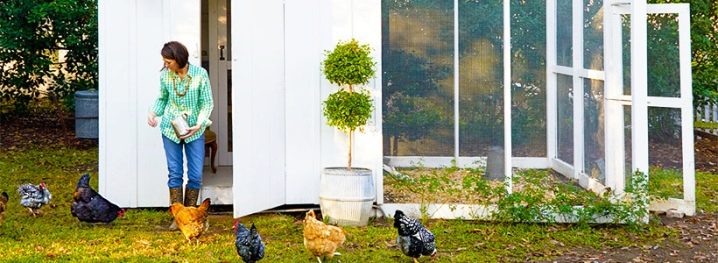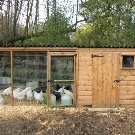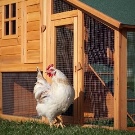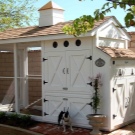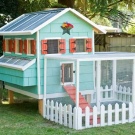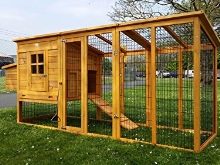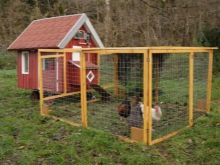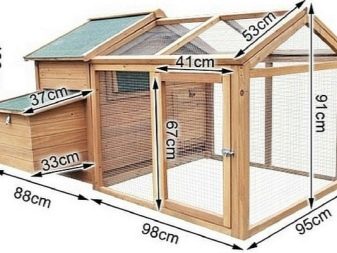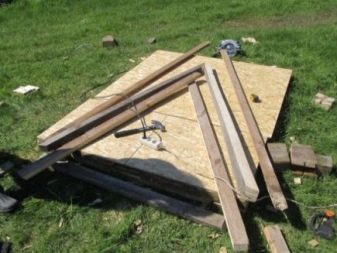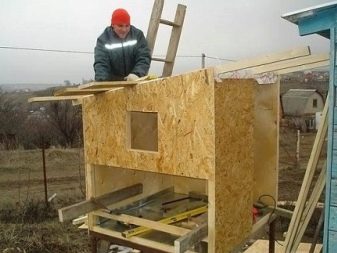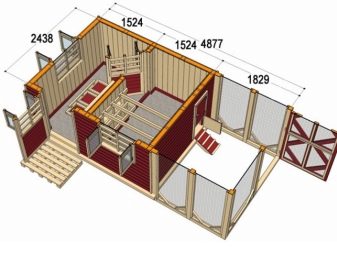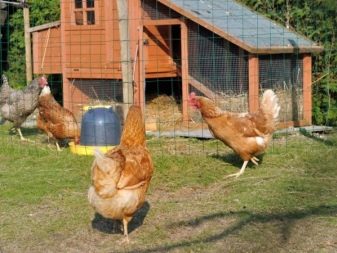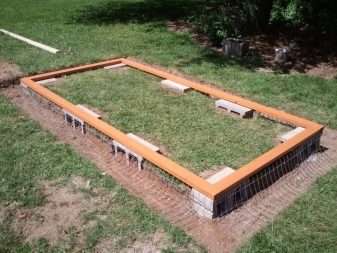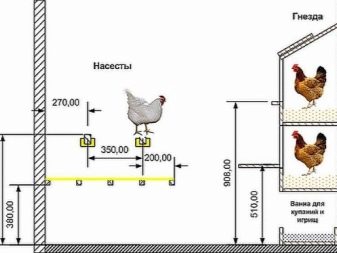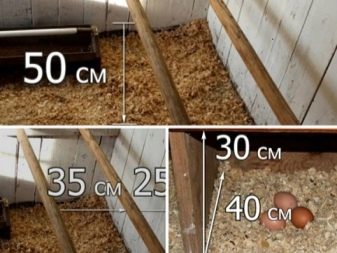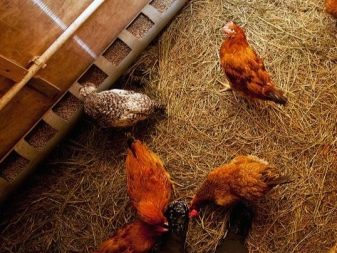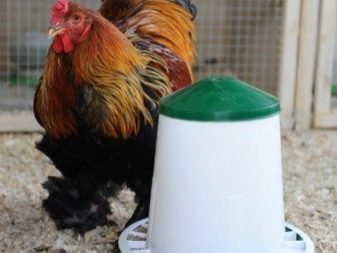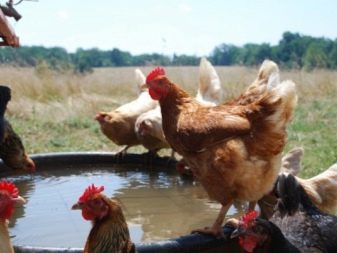How to build a chicken coop for laying hens?

Recently, the breeding of poultry is gaining increasing popularity. Chickens allow not only year-round to have homemade eggs, but also meat. Feathers chickens can be used as a filler for feather pillows and blankets. However, in order not to face serious problems, it is necessary at the initial stage to think over this idea well, paying special attention to the construction of the chicken coop.
How to choose the appropriate option?
Competently built chicken coop for laying hens is not a barn, but a separate small, warm structure, with the most correct and close to the natural conditions for the maintenance and breeding of poultry.In the right "house" is convenient not only to chickens. The owner can easily restore order, feed and care for animals.
The ideal option could be a chicken coop, consisting of 2 parts. The first one is represented by a closed, comfortable room, and the second one by an enclosure enclosed with a special net for walking birds. It is also possible to purchase or manufacture self-portable models of chicken coops, however, they are not suitable for keeping a large number of hens.
When designing an individual chicken coop, it is necessary to consider the following subtleties:
- the device of thermal insulation is necessary, especially when keeping birds all year round;
- the safety of the building must be at its best, this will prevent the loss of chickens and eggs due to the attack of predators;
- ventilation is needed for ventilation of the chicken coop and a constant supply of fresh air, however, there must be no draft, otherwise many animal diseases will not be avoided;
- To increase the production of chicken eggs, it is necessary to organize artificial lighting at some time of the day.
Nevertheless, there are no strict rules in the construction of the pens for chickens, and everyone can independently design a suitable object for 500, 1000, 10 or 200 birds.
Device and drawings
Build a chicken coop alone is not very difficult and even a beginner can. First of all, you should decide on the future construction plan and draw up a schematic drawing with dimensions. You can take ready-made drawings, however, it is better to prepare them yourself based on individual requirements and sizes.
When determining the size, it is necessary to take into account what the maximum number of birds is planned to contain, and to make a start from this figure in the calculations. It is optimal to settle 4 chickens per square meter.
When the design of the future chicken coop is determined, you need to prepare materials:
- gravel, water, sand, formwork, concrete and metal mesh;
- gas block, brick or frame;
- floor boards;
- slate or ruberoid;
- insulation (for example, isover);
- plywood for interior design;
- windows (can be made independently, can be ordered individually in specialized firms);
- ventilation;
- chain-link for the pen;
- wires and lamps;
- dimmer or 2 switches;
- hardware.
All necessary materials can be purchased at any hardware store. The internal arrangement of the chicken coop depends on the individual needs, but must necessarily have roosts, feeding troughs, nests and equipped feeding places.
How to build?
Follow the work plan, which looks like this:
- location selection;
- foundation device;
- flooring flooring;
- walling;
- roofing;
- window insertion and ventilation device;
- work on the internal improvement of the chicken coop.
Having prepared the drawings and all the necessary materials and tools, you can begin to build a chicken coop with your own hands. Particular attention should be paid to the choice of place for the construction of buildings. It should be located on a hill, away from excessive moisture and drafts.
The foundation begins to settle with the preparation of the soil. To do this, the top layer of the earth is removed (20-30 cm) and covered with gravel and sand. Formwork is being prepared, a metal grid is laid on it and concrete is poured. This type of foundation is the most fundamental, although other support options can be used. The floor is covered with boards, if desired, you can pour a small (up to 10 centimeters) layer of expanded clay under the floor. This will allow to warm the room and make the temperature in it more comfortable for the hens.
Walls can be built from various materials. If walls are erected from a log house, then there is no need for their additional warming, and a sufficiently comfortable temperature is maintained in them anyway.It is better to warm brick or gas-concrete walls both outside and inside.
The roof of most projects chicken coop duo. This allows you not to linger on her moisture. The roof can also be insulated by placing isover or mineral wool under slate or tile. The number of windows in the building is calculated from a ratio of 1 to 12, relative to the floor area. It is advisable to supplement the windows with mosquito nets, which will prevent the entry of insects into the room of the chicken coop.
Air vents are fitted in the wall and allow for proper circulation of fresh air. After completion of all external work, you can proceed to the interior decoration of the hen house.
How to equip the inside?
The equipment of the chicken coop from the inside is one of the most critical stages of construction. First of all, you should decide on a list of what must be in the right hen house, and this is:
- sleeping places;
- nests;
- feeding cups;
- capacity for water treatments;
- place for walking.
Separately, you should understand the lighting. The main thing in the device of wires and lamps is to place them as high as possible in order to avoid traumatizing the birds.The locking elements must be securely fastened and not have sharp accessible parts, so that the chickens will not hurt about them. When lighting the device, you should know one peculiarity of the domestic hens - they are very poorly oriented in the dark and if you suddenly remove the light, then not all of them can get settled at night and fall asleep in an uncomfortable position on the floor. First, turn off the main light, and then, after the hens are seated in their places, turn off completely. Therefore, it is necessary to provide a main bright light and an additional one, with a dim lamp or to install a dimmer, which allows you to smoothly adjust the intensity of illumination.
Berth is represented in the henhouse roost. This is a universal object that birds use not only for recreation, but also for sleep. According to some reports, domestic chickens spend about half of their lives on the roost, so it should be comfortable and safe.
Perches are made of wooden bars, smooth branches of large trees.
The berth should meet the following requirements.
- Strength. Too thin crossbar can break under the weight of birds, while causing injury to them.
- Security. The cutting before installation is necessarily processed by a plane and, if necessary, brought to smoothness with the help of emery paper. All sharp corners must be removed, otherwise the birds can damage the paws and “de-multiply”.
- Sufficient landing area. In the warm season and off-season, one chicken should account for at least 20 centimeters. In the cold season, this indicator is reduced for the purpose of a closer arrangement of the hens, so that they do not freeze.
Installation of plastic structures is unjustified, since plastic does not have the environmental friendliness and durability of wood and can damage birds when it breaks with sharp edges.
For the device jacks should choose a comfortable and spacious place. The egg production of chickens will depend on the correctness and convenience of installing this item in the chicken coop. It is necessary to have their secluded corners, which are not penetrated by daylight. The nest can be made from a wooden or plastic box of suitable size. For an adult hen it is better to take a nest of 40x60 centimeters.
Straw is laid in a thick layer inside the nests and changed regularly. It is not recommended to put these constructions under perches - the hens will crap and endlessly pollute the straw inside.
The feeding area can be equipped in 2 ways.
- Feed can be poured on chickens in a certain place, directly on the litter. Thus, the natural need of birds to crawl in search of food is satisfied. The only condition is to locate the feeding place as far as possible from the habitats of active chickens.
- Arrangement of special feeders. They can both be made independently from improvised containers, or purchased in a specialized store. But this method has several disadvantages. Chickens do not belong to very neat creatures and love to dig in food, so you have to clean this “kitchen” very often. The birds are also squabbling and often cannot share food, which may ultimately end in a fight and an inverted feeder.
Water tanks in the hen house should be required. It is better to give preference to modern auto-drinkers, which serve as needed new portions of water.
All birds love water treatments and chickens are no exception. However, poultry do not use water, dust or sand for this purpose. In order for layers to comfortably perform hygienic procedures, it is necessary to install a large tank with sand.During the "bathing" chickens get rid of parasites, which could catch, for example, lice, which, when the process is neglected, it can be very difficult to remove. Therefore, do not neglect the installation of the bath in the hen house.
In order for the hens to carry eggs and be healthy, they need fresh air and sun, and therefore, a specially equipped stall for walking. Do not send domestic chickens in the "free swimming" in the yard, as they are in a short time can mess up a lot of confusion and cripple themselves. And if there is a vegetable garden, then it’s better not to let the birds at all, because they will peck, eat and dig everything around. But keeping the birds indoors, without a walk, is fraught with serious health problems.
To equip the correct corral should do so:
- on the side of the door - the entrance to the chicken house - with a grid fenced paddock;
- poles digging around the perimeter and a metal grid attached to them;
- mount carefully, avoiding the formation of sharp edges that can damage the bird;
- Be sure to bury the net in the ground for 40 centimeters. This measure will protect chickens from predators who can dig a course to the pen;
- the height of the fence - 200 centimeters. Domestic chickens - beautiful flyers for short distances and without problems jump over a fence with a height of 150 and even 170 cm.
To independently build a house for laying hens, it does not require a lot of costs and the availability of special knowledge and skills in the field of construction. However, you should take into account the features of these birds, then you will be able to create favorable conditions for them to live and breed.
About what should be in the chicken coop for laying hens, see the next video.
